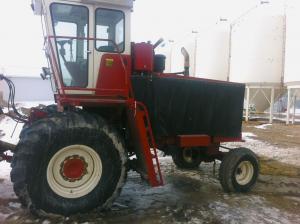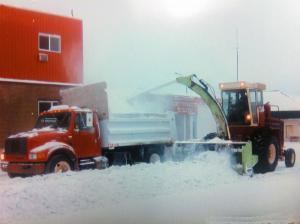2014 - Volume #38, Issue #3, Page #16
[ Sample Stories From This Issue | List of All Stories In This Issue | Print this story
| Read this issue]
Tractor Built From Case Combine
 |
 |
“Big cities have them, but our town couldn’t afford a commercial rig,” says Ford, who is a city maintenance worker for his small town. “Using a front-end loader is slow and dangerous around car traffic.”
Ford decided to go with a Case IH 915 combine for its heavier final drives, heavier transmission and turbocharged engine. He figured the 135 hp. would be needed for the 11-ft. snowblower he planned to use.
After stripping down the combine, Ford began repositioning the components he needed on an old truck frame cut down to 14 ft. He reinforced the cross members and rebuilt all the clutches with new bearings.
Ford narrowed the combine drive axle by a foot before mounting it, along with the steering axle, engine and transmission, to the frame. He also mounted the original cab, fuel tank and hydraulics.
In preparation for mounting the snowblower, Ford welded a 1-in. thick plate to the front end of the frame just ahead of the drive axle. To adapt the combine motor to drive the snowblower, he used a pto case off a Case 2670 tractor. After drilling a hole through the plate for the driveshaft, Ford mounted the pto case to the blower side of the steel plate.
He fabricated a 3-pt. hitch on back of the steel plate using tabs with 1-in. holes welded to the plate on either side of the pto case. For lift, he mounted the combine header lift cylinders to the outside of the truck frame, which push on the lower arms of a rocker shaft mounted to the top of the steel plate. As the shaft turns, it provides lift for the 3-pt. arms mounted to the tabs.
In order to use the separator clutch on the combine to engage and disengage the pto, Ford took the drive pulley from the separator drive to a machine shop.
“They salvaged the splines and mated them to the U-joint on the end of the 2670 driveshaft,” says Ford. “This meant I could use the separator clutch lever in the cab to engage the snowblower with direct engine power.”
When Ford ran into problems with insufficient hydraulic pressure for the hydrostatic transmission, a mechanic suggested separating hydraulics from hydrostatics. He now uses the hydrostatic system with its own pump and reservoir for drive. A second pump and reservoir service other hydraulic needs such as the discharge chute, 3-pt. lift, steering, etc. He also installed electric-over-hydraulic switches on all the valves for easier control while driving.
Ford found a used 1100 Schulte snowblower. He put all new sprockets and bearings on and relined the impeller. At 110 in., it clears a path well past the 9-ft. tractor wheel width.
“I can load about 12 yards of heavy, wet snow in about a minute and 12 seconds,” says Ford. “The blower beats the air out of the snow, too, so every load is about 50 percent heavier. It is faster than a front-end loader. It is a poor man’s fix for a small town that couldn’t afford a new rig.”
Ford estimates he paid $2,800 for the combine, but the town has since reimbursed him for all his costs. “When I told my boss what I wanted to do, he thought I was crazy,” recalls Ford. “When I showed him my friend’s tractor, he understood and said that if it worked, the town would reimburse me. It’s now in its sixth season and has been trouble free. I put on 100 to 150 hrs. every season.”
Contact: FARM SHOW Followup, Kevin Ford, P.O. Box 218, Kelvington, Sask. Canada S0A 1W0 (ph 306 327-4764; klfordx2@gmail.com).

Click here to download page story appeared in.

Click here to read entire issue
To read the rest of this story, download this issue below or click here to register with your account number.




